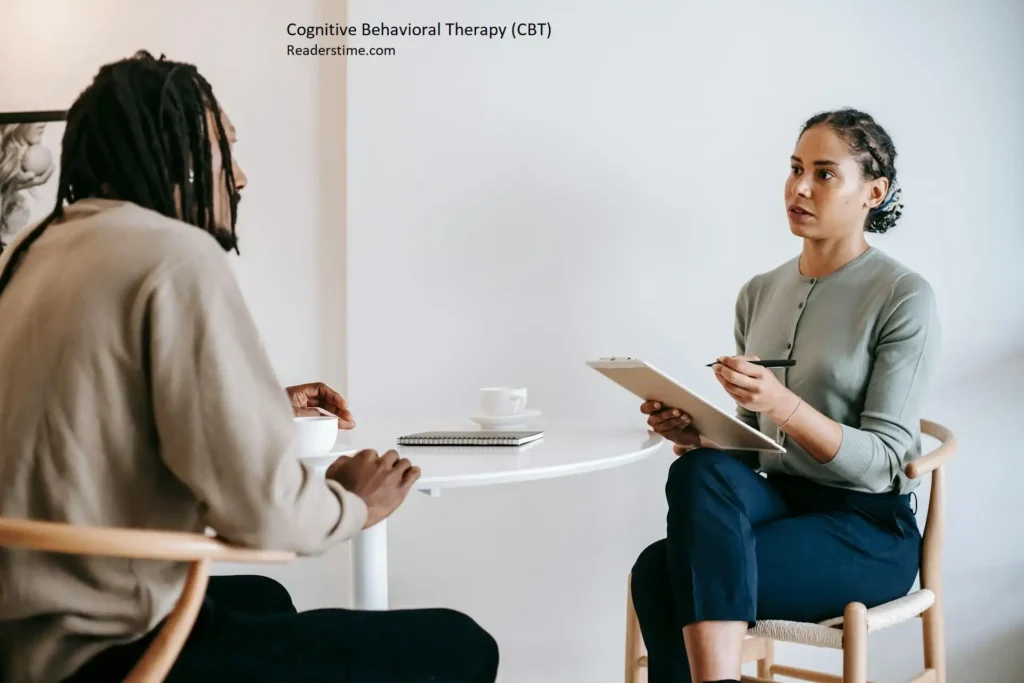Understanding Cognitive Behavioral Therapy (CBT) With Techniques and Benefits

Cognitive Behavioral Therapy (CBT) is a form of psychological treatment that has been demonstrated to be effective for a range of problems including depression, anxiety disorders, alcohol and drug use problems, marital problems, eating disorders, and severe mental illness. Numerous research studies suggest that CBT leads to significant improvement in functioning and quality of life. In this article, we will explore the fundamentals of CBT, how it works, and its benefits.
What is Cognitive Behavioral Therapy?
CBT is based on the concept that our thoughts, feelings, physical sensations, and actions are interconnected, and that negative thoughts and feelings can trap us in a vicious cycle. CBT aims to help people deal with overwhelming problems more positively by breaking them down into smaller parts. It encourages individuals to change their patterns of thinking or behavior that are causing them problems, and by doing so, change the way they feel.
The Core Principles of CBT

Thoughts Influence Emotions and Behaviors
CBT is based on the idea that our thoughts affect our feelings and behaviors. For example, if someone interprets a social situation negatively, they are likely to feel anxious and behave in a withdrawn manner.
Problem-Solving Approach
CBT is a structured, goal-oriented therapy. It focuses on solving specific problems rather than delving into past experiences.
Short-Term Treatment
CBT is typically a short-term therapy, often lasting between 5 to 20 sessions, depending on the issue at hand.
Active Participation
CBT involves active participation from the patient, including homework assignments outside of therapy sessions to practice the skills learned.
How CBT Works
CBT works by helping individuals identify and change their dysfunctional thinking patterns and behaviors. Here’s how a typical CBT process might unfold:
Assessment
The therapist works with the patient to identify specific problems and goals. This involves discussing the patient’s thoughts, feelings, and behaviors to understand the issues they are facing.
Identifying Negative Thoughts
The patient learns to identify automatic negative thoughts and understand how these thoughts influence their emotions and behaviors.
Challenging Negative Thoughts
The therapist helps the patient challenge these negative thoughts and replace them with more realistic and positive ones. This can involve questioning the evidence for their negative thoughts, considering alternative perspectives, and assessing the real impact of their concerns.
Behavioral Activation
This involves helping the patient engage in positive activities and behaviors that can improve their mood and reduce anxiety.
Developing Coping Strategies
The patient learns specific skills and strategies to manage their problems, such as relaxation techniques, mindfulness, and problem-solving skills.
Techniques Used in CBT
Cognitive Behavioral Therapy (CBT) incorporates a variety of techniques to help patients achieve their therapeutic goals. These techniques are designed to address different aspects of cognitive and behavioral patterns, facilitating positive change and improving overall mental health. Here are some of the most commonly used techniques in CBT.
Cognitive Restructuring or Reframing
Cognitive restructuring, also known as cognitive reframing, is a core technique in CBT. It involves identifying and challenging negative thought patterns and replacing them with more positive, realistic ones. The process includes:
Identifying Negative Thoughts: Patients are taught to recognize automatic negative thoughts that arise in response to various situations.
Evaluating Evidence: Patients assess the evidence for and against these negative thoughts, often realizing that their initial interpretations may be flawed or exaggerated.
Reframing: Patients learn to reframe their thoughts, developing alternative, more balanced perspectives that can lead to healthier emotional responses and behaviors.
Exposure Therapy
Exposure therapy is a highly effective technique used primarily to treat phobias and anxiety disorders. The technique involves gradually and systematically exposing the patient to the feared object or situation in a controlled and safe environment. The steps typically include:
Creating a Fear Hierarchy: Patients and therapists work together to list feared situations in order of intensity.
Gradual Exposure: Patients start with the least feared situations and gradually progress to more challenging ones.
Desensitization: Repeated exposure helps reduce fear and anxiety over time, as patients learn that their feared outcomes are unlikely or manageable.
Behavioral Experiments
Behavioral experiments are practical tests designed to challenge the patient’s beliefs and assumptions through real-life experiences. This technique helps patients discover the inaccuracy of their negative predictions and fosters more adaptive thinking. The process involves:
Formulating Hypotheses: Patients predict the outcomes of certain behaviors based on their current beliefs.
Conducting Experiments: Patients engage in activities that test these predictions.
Reviewing Results: Patients analyze the outcomes to see if their fears were justified, often finding that their predictions were overly pessimistic.
Activity Scheduling and Planning
Activity scheduling and planning is a technique used to help patients engage in positive and rewarding activities. This approach is particularly effective for those dealing with depression, as it helps break the cycle of inactivity and low mood. Key components include:
Identifying Enjoyable Activities: Patients list activities they find pleasurable or meaningful.
Creating a Schedule: Patients plan and schedule these activities, ensuring they are integrated into their daily routine.
Tracking Progress: Patients monitor their engagement in these activities and their impact on mood and overall well-being.
Mindfulness and Relaxation Techniques
Mindfulness and relaxation techniques are essential tools in CBT for managing stress and anxiety. These techniques encourage patients to focus on the present moment and develop a state of calm. Common practices include:
Mindful Breathing: Focusing on the breath to center the mind and reduce stress.
Progressive Muscle Relaxation (PMR): Tensing and relaxing different muscle groups to promote physical relaxation.
Guided Imagery: Visualizing peaceful and calming scenarios to reduce anxiety.
Deep Breathing Exercises: Taking slow, deep breaths to lower heart rate and promote relaxation.
Integrating Techniques for Effective Therapy
CBT is a versatile and evidence-based approach that tailor’s techniques to individual patient needs. By combining cognitive restructuring, exposure therapy, behavioral experiments, activity scheduling, and mindfulness practices, therapists can help patients develop practical skills to manage their mental health challenges. Regular practice and application of these techniques empower patients to achieve lasting improvements in their emotional and psychological well-being.
Benefits of Cognitive Behavioral Therapy (CBT)
Cognitive Behavioral Therapy (CBT) is widely recognized for its effectiveness in treating a variety of mental health issues. Its structured, goal-oriented approach offers numerous benefits that contribute to its popularity and success. Here are some of the key benefits of CBT:

Evidence-Based
CBT is backed by extensive research, making it an evidence-based therapy. Numerous studies have demonstrated its effectiveness in treating a broad spectrum of mental health conditions. The rigorous scientific validation behind CBT ensures that it is a reliable and credible therapeutic approach.
Empowerment
One of the significant advantages of CBT is its focus on empowering patients. CBT equips individuals with practical skills and strategies that they can use to manage their problems independently. By learning to identify and challenge negative thought patterns, patients gain control over their thoughts and behaviors, leading to increased self-efficacy and confidence.
Flexibility
CBT is a highly adaptable form of therapy that can be tailored to address a wide range of mental health issues. Whether dealing with depression, anxiety, Post-Traumatic Stress Disorder (PTSD), Obsessive-Compulsive Disorder (OCD), eating disorders, or substance abuse, CBT provides versatile techniques that can be customized to meet the specific needs of each patient.
Short-Term
Unlike some other therapeutic approaches, CBT is typically a short-term treatment. Most CBT programs last between 5 to 20 sessions, making it a time-efficient and cost-effective option for many individuals. The short duration of CBT allows patients to experience significant improvements in a relatively brief period.
Who Can Benefit from CBT?
CBT is beneficial for individuals of all ages, including children, adolescents, and adults. It is particularly effective for those dealing with the following conditions:
Anxiety Disorders
CBT is highly effective in treating various anxiety disorders, including panic disorder, social anxiety disorder, generalized anxiety disorder, and specific phobias. By addressing the underlying cognitive distortions and behavioral patterns that contribute to anxiety, CBT helps patients reduce their symptoms and improve their quality of life.
Depression
CBT is one of the most effective treatments for depression. It helps individuals identify and challenge the negative thought patterns and behaviors that contribute to their depressive symptoms. Through CBT, patients learn to develop healthier ways of thinking and coping, leading to improved mood and functioning.
Post-Traumatic Stress Disorder (PTSD)
CBT is a cornerstone treatment for PTSD. It helps patients process traumatic experiences, reduce distressing symptoms, and develop coping strategies. Techniques such as cognitive restructuring and exposure therapy are particularly beneficial for individuals with PTSD.
Obsessive-Compulsive Disorder (OCD)
For individuals with OCD, CBT, particularly Exposure and Response Prevention (ERP), is highly effective. ERP involves gradually exposing patients to their feared objects or situations while preventing their typical compulsive responses. This process helps reduce the intensity of obsessive thoughts and compulsive behaviors.
Eating Disorders
CBT is a valuable treatment for eating disorders, such as bulimia nervosa and anorexia nervosa. It addresses the distorted thoughts and behaviors related to food, body image, and self-worth. By challenging these patterns, CBT helps patients develop healthier relationships with food and their bodies.
Substance Abuse Disorders
CBT is effective in treating substance abuse disorders by helping individuals recognize and change the thought patterns and behaviors that contribute to their substance use. CBT provides strategies for coping with cravings, avoiding triggers, and developing healthier alternatives to substance use.
Conclusion
Cognitive Behavioral Therapy offers a wealth of benefits for individuals struggling with a wide range of mental health issues. Its evidence-based approach, emphasis on empowerment, flexibility, and short-term nature make it an attractive and effective treatment option. Whether dealing with anxiety, depression, PTSD, OCD, eating disorders, or substance abuse, CBT provides the tools and strategies necessary for lasting improvement in mental health and overall well-being. CBT empowers individuals to lead healthier, happier lives.
If you or someone you know could benefit from CBT, consider reaching out to a licensed therapist who specializes in this form of treatment. With the right support and strategies, it’s possible to overcome mental health challenges and improve overall well-being.

